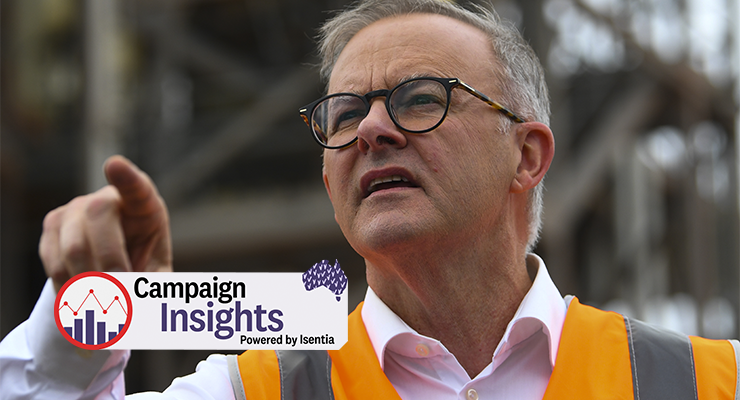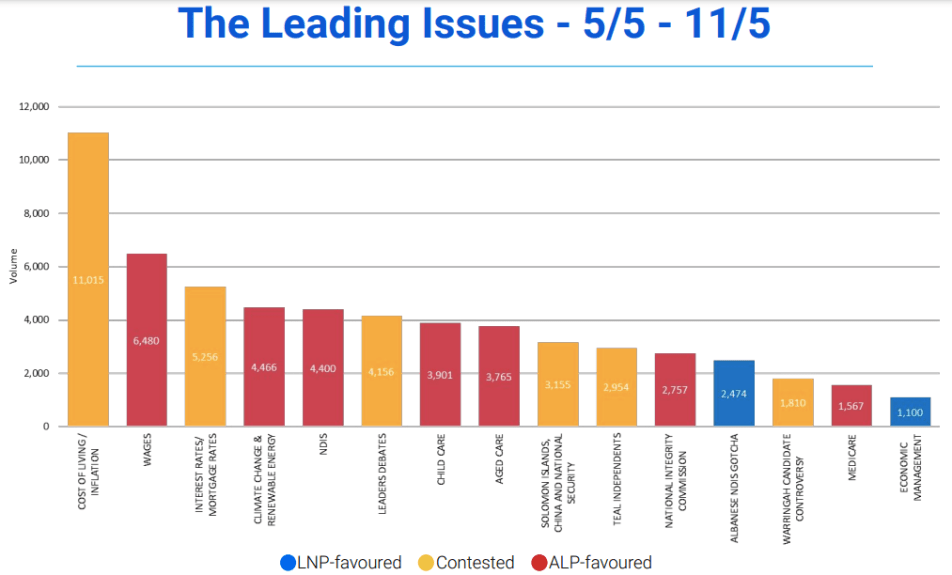
One of the biggest problems for Scott Morrison’s reelection campaign has been his inability to turn the campaign to issues favourable to himself and the Liberals. And it’s gotten significantly worse over the last week, Crikey’s latest data from Isentia shows.
In the seven days to Wednesday this week, only two of the top 15 issues in election coverage were favourable to the Coalition. The rest either break both ways, or favour Labor. The dominant issue, of course, was cost of living, which has increasingly become a Labor issue as inflation and interest rates have become centrepieces of campaign debate.
The second biggest issue, of course, was wages. Labor must be unable to believe its luck that — allegedly as the result of an accident — days of the campaign were given over to the simple framing that Labor wants low-paid workers to get a pay rise and Scott Morrison — backed by the media — doesn’t.
Other, guaranteed pro-Labor issues like NDIS, aged care, childcare and climate all continue to feature in coverage — a kind of background hum that keeps the government from switching the narrative to a strong economy and national security.

The week also saw Anthony Albanese secure parity with Morrison in terms of coverage — something he struggled with early in the campaign and particularly while in lockdown. That reflects two leaders debates during the period, but also the sense that Albanese is now the alternate prime minister more than an opposition leader.
Isentia’s data shows Treasurer Josh Frydenberg, primarily as a result of his desperate battle to hold on against independent Monique Ryan in Kooyong, was the third-most covered figure — Labor’s opposition treasurer Jim Chalmers, after a high profile the previous week, has slipped down the list of most covered politicians. Unfortunately for the Liberals, Malcolm Turnbull was the next highest-profile figure after Frydenberg, while Katherine Deves continued to pursue the limelight, maintaining her role of generating a near-constant transphobic buzz for the Liberals in Sydney.
Ryan lifted her level of coverage to its highest level yet against Frydenberg. As Isentia noted, “the Frydenberg campaign would undoubtedly be uncomfortable with the way Ryan has garnered such publicity, and perhaps would reconsider their media strategy given it has only contributed to her name recognition”. The News Corp and Liberal campaigns against Ryan and other teal independents have only served to boost their name recognition and award them de facto opposition status.
In Wentworth, independent Allegra Spender actually had more coverage than Liberal incumbent Dave Sharma, by a narrow margin, for the first time in the campaign. In Boothby in South Australia, for the second week in a row, independent Jo Dyer dominated her rivals in terms of coverage.
Isentia’s clever way of plotting what topics the leaders addressed in debates shows a striking contrast between the debates on Nine and Seven. In the brawling, poorly managed Nine debate, while Albanese and Morrison still hammered their preferred points, both were forced to talk about issues their opponent wanted to discuss. For example, Albanese had to talk about national security more than an integrity commission or cost of living, while Morrison was forced to talk about health care and interest rates nearly as much as economic management.
The Seven debate, in contrast, was a reversion to form, with the graph of the leaders’ topics returning from the Nine cluster to the L-shape of the first debate, in which the leaders stuck to their preferred topics. Indeed, moderator Mark Riley sarcastically complimented Morrison on “smashing out the talking points” after a particularly rapid and lengthy iteration of factoids and key messages from the prime minister at the start. Maybe a shambolic free-for-all is the best format for a debate to see leaders pushed outside their comfort zones.








What are Morrison’s preferred subjects? The economy? The RBA just torpedoed the floating wreckage. National security? The Solomon Islands is lovely this time of year. Boats? Yes, BOATS!!
Meanwhile, Morrison’s campaign has gone:
Week 1: You know me.
Week 3: You may not like me but you need me.
Week 5: I can change!
The Libs frequent Facebook ads still hammer the Labor is weak on the economy , you can’t trust Labor, taxes will be higher under Labor and so on. All lies but then they are Morrison’s apecialty.
I do think that that the perception of Morrison as a liar has seriously undermined the willingness of many to listen to anything he says.
And for revealing this reputation we have much to thank Crikey for.
Hear Hear..!! I will be very happy to attribute credit to Crikey for valuable assistance in the case that Labor does actually win.
If they don’t, I will ride off into the sunset, never to be seen again.
Yes, thank you to Crikey.and without taking away from Crikey’s work in any way thanks to Morrison himself for being unable to stop lying and for being too arrogant, stupid, unable to accept (insert other words here as required!) that he has been caught out and hhis immediate lie to den it is there for all to see. What a pity the MSM are too afraid to pursue him.
PS I like Katherine Murphy’s post in The Guardian this afternoon.
I wonder where Ms Markson got her information about the number of times Richard Marles has spoken to the Chinese from? Surely not from one of our own Agencies?
The more he sees it all slipping away the nastier he’ll become. (“Forgive me Lord, but I must do this for the good of the nation.”)
Commentators, including Bernard, have said that Deves is doing a job for Morrison in maintaining transphobic messaging in Sydney. I wonder whether she could be doing a good job, though I wonder how it could possibly be good that she treats transgender people as victims of attacks on their genitals? For loopiness, how on earth could she be conceived as someone standing up for women like people stood up for Jews against the Nazis? Are women being sent for medical experiments in Australia, as Doctor Mengele experimented on Jewish women in his clinic? Really? Does Deves really think that adults who consent to gender reassignment surgery are being “mutilated”, when that is the legal term only for violence inflicted on people’s genitalia or other body parts? Why does she treat her audience as though it cannot tell the difference between an adult consenting to a fully explained procedure after suffering gender dysphoria for many years with violence inflicted on a person’s genitals without their consent? Does she think that the level of stupidity in the US revealed by Trump’s “Make America Great Again” campaign is the general level of stupidity in countries like Australia, which have never been “Great”, or even Great Britain, which once celebrated being “Great”? For, surely, MAGA campaign levels of stupidity would be needed to get anyone to agree that surgery is “mutilation”, when it is done well with an adult’s informed consent.
Bernard could have observed that Morrison’s men are getting desperate when Alex Hawke proposes to charge people the costs involved in being deported for a “bad character”. Does he really think that this will win anyone’s vote or that it will switch election issues to hatred of immigrants? This level of desperation suggests they fear they are going down the drain where, IMO, they belong.
I don’t know whether the story headed “Scott Morrison has made a gruesome election bet, and it’s moderate Liberals like his deputy Josh Frydenberg who stand to lose” . . .
at . . .
https://www.abc.net.au/news/2022-05-14/josh-frydenberg-loses-kooyong-cant-blame-labor-campaign-idiocy/101064198
. . . was damaged by a subeditor aka copyeditor before publication, but it says . . .
Does the ABC story carelessly misrepresent The Australian’s words? An 80-seat majority, ie a positive margin of 80 seats, for the ALP? In my wildest dreams. Not only unprecedented, but in the real world also fanciful.